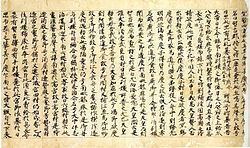 | ||
Fudoki (風土記) are ancient reports on provincial culture, geography, and oral tradition presented to the reigning monarchs of Japan, also known as local gazetteers. They contain agricultural, geographical, and historical records as well as mythology and folklore. Fudoki manuscripts also document local myths, rituals, and poems that are not mentioned in the Kojiki and the Nihon Shoki chronicles, which are the most important literature of the ancient national mythology and history. In the course of national unification, the imperial court enacted a series of criminal and administrative codes called ritsuryō and surveyed the provinces established by such codes to exert greater control over them.
Contents
Kofudoki
In the narrower sense, Fudoki refer to the oldest records written in the Nara period, later called Kofudoki (古風土記) (Old-Fudoki). Compilation of Kofudoki began in 713 and was completed over a 20-year period. Following the Taika Reform in 646 and the Code of Taihō enacted in 701, there was need to centralize and solidify the power of the imperial court. This included accounting for lands under its control. According to the Shoku Nihongi, Empress Genmei issued a decree in 713 ordering each provincial government (ja:国衙, kokuga) to collect and report the following information:
Names
Empress Genmei ordered in 713 that place names in the provinces, districts, and townships should be written in two kanji characters with positive connotations. This occasionally required name changes. For example, Hayatsuhime (速津媛) became Hayami (速見) and Ishinashi no Oki (無石堡) became Ishii (石井).
Manuscripts
At least 48 of the Gokishichidō provinces contributed to their records but only that of Izumo remains nearly complete. Partial records of Hizen, Bungo, Harima and Hitachi remain and a few passages from various volumes remain scattered throughout various books. Those of Harima and Hizen are designated National Treasures.
Below is a list of extant manuscripts and scattered passages.
Parks
In 1966 the Agency for Cultural Affairs called on the prefectural governments to build open-air museums and parks called Fudoki no Oka (風土記の丘, "Fudoki Hills") near historic sites such as tombs (kofun) and provincial temples. These archaeological museums preserve and exhibit cultural properties to enhance public understanding of provincial history and culture.
